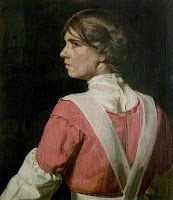To Grafton Gallery where the most mixed show (Allied Artists Assocn.) you ever saw.
The Allied Artists Association was founded by Frank Rutter, art critic of The Sunday Times newspaper, in 1908. Its purpose was to provide a platform for the exhibition and promotion of modernist art in Britain. The AAA organised exhibitions at various venues, most notably an annual Salon in Paris. In an advertisement for the AAA in 1917, in the literary journal Art and Letters, it was announced that the aim of the AAA was to organise exhibitions without the use of a selecting jury, with each member having 'the right to show any three works he (or she) pleases and to have one work hung on the line.' In June 1917 the AAA held a show at the Grafton Galleries, London.
Tea at Hatchetts.
Then to Westminster Cathedral for evensong. Beautiful darkening empty building, very sad, and a sing-song by six priests and their leader.
I dined at the Reform alone, and alone to the Alhambra. Very empty.
The Alhambra was a popular theatre and music hall located on the east side ofLeicester Square, in the West End of London. It was built originally as The Royal Panopticon of Science and Arts but closed after two years and reopened as the Alhambra. The building was demolished in 1936. The name comes from association with the Moorish splendour of the Alhambra palace in Granada. During World War I, a series of hit revues played at the Alhambra that included The Bing Boys Are Here (1916), which featured the first performances of the song "If You Were The Only Girl In The World".
 |
Miss Wish Wynne (1882–1931), in the Character of Janet Cannot for the Play 'The Great Adventure' by William Nicholson |
I slept at the R.T.Y.C. Thursday morning, long seance at barber's. Then to W. Nicholson's. He was in a black leather jacket covered in paint. He gave me the portrait of Wish Wynne that was used in the production of "The Great Adventure". He showed me some most ingenious 'still lifes', and Eric Kennington's biggish war picture - very striking.
<http://www.iwm.org.uk/collections/item/object/15145>
Sir William Newzam Prior Nicholson (1872 – 1949) was an English painter of still-life, landscape and portraits, also known for his work as a wood-engraver, illustrator, author of children's books and designer for the theatre. From 1893 to 1898 Nicholson collaborated with James Pryde in designing posters. Their partnership was conspicuous for striking graphical work and woodcuts—they were known as the Beggarstaff Brothers, and their poster work was significant historically.



No comments:
Post a Comment